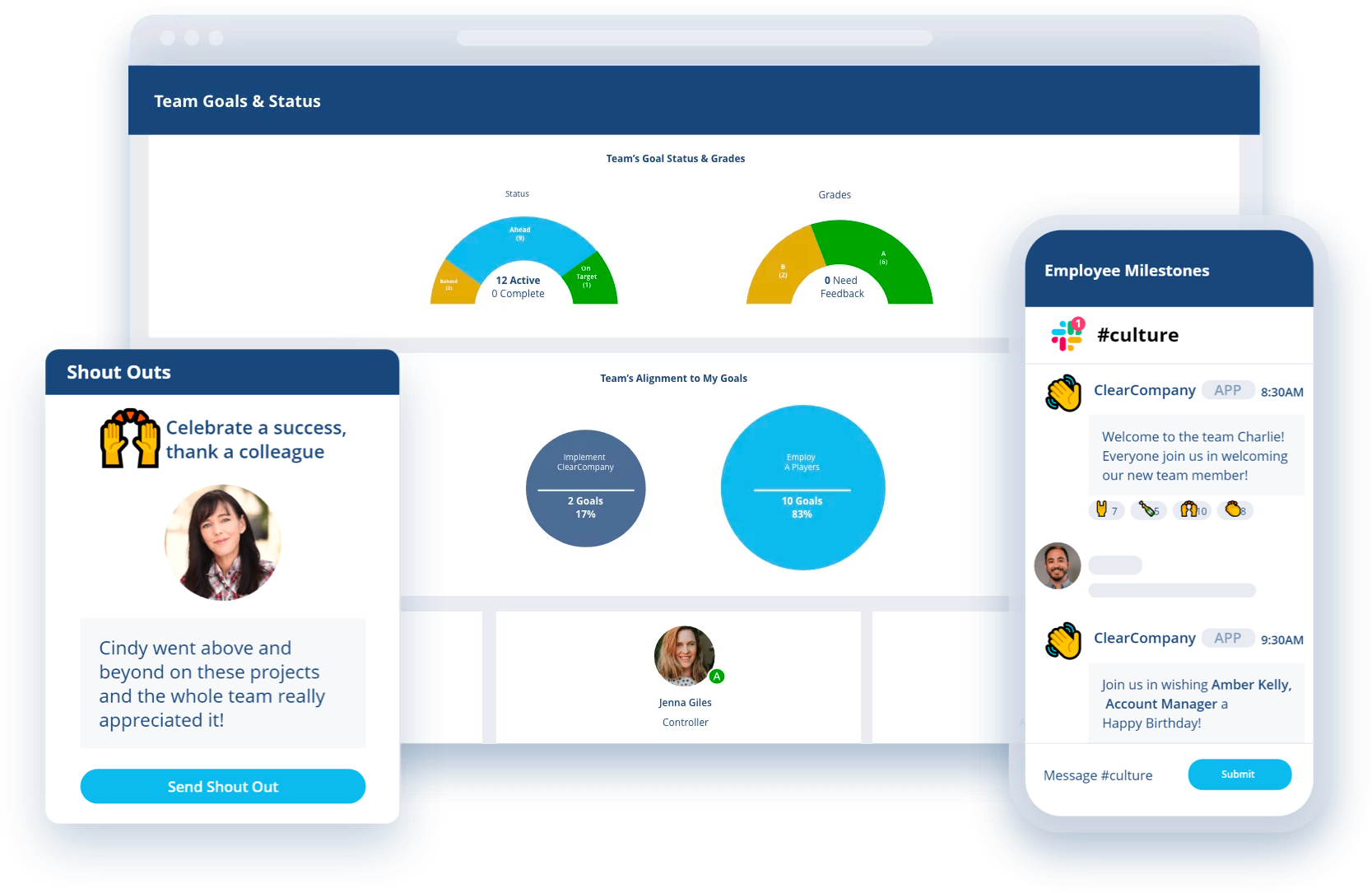This post on improving employee engagement was published in February 2021 and was updated in April 2024 with new information and statistics.
We often discuss the importance of employee engagement, which has a huge impact on both your people and your business. Extensive research by firms like Gallup proves that most successful organizations spend time and effort ensuring their employees are supported in their roles and engaged with their work. Engaged employees are more likely to outperform their peers, have an increased motivation to produce high-quality work, and remain in their roles for a longer period of time.
Your employee engagement strategy is more important than ever in 2024. Since 2021, the engagement rate in the U.S. has fluctuated —first, dropping from 36% to a 20-year low of 32%. While engagement is trending upward again, between these recent patterns and its significant impact on all parts of the business, it’s never a bad time to focus on improving employee engagement.
Keep reading for more on why ensuring your employees feel supported, motivated, and welcome at work is so critical for business success. First, we’re digging into what it means for employees to be engaged. Then, we’ll take a look at what kind of company culture and work environments are conducive to high engagement. And last but not least, we’ll share six tips for increasing employee engagement levels.
What Does It Mean to Be Engaged at Work?
The question of what employee engagement is has been thoroughly researched for more than two decades. The research shows that engagement is about how much employees care about what they do and feel seen and heard by their employer. Are they motivated to do their best and feel a sense of belonging at their workplace? If the answer is yes, it’s likely those employees are engaged.
When employees are enthusiastic about their work and feel like they matter, they’re going to produce higher-quality work and stick around longer. When employees are engaged, companies’ turnover rates are as much as 43% lower than at companies with low engagement; they also experience 41% fewer quality defects. It only makes sense that people stay at companies where they’re treated like people and equipped to do their jobs well.
What Drives Employee Engagement?
High engagement doesn’t happen by accident — it needs to be purposefully cultivated. Luckily for human resources teams that want to strengthen their strategy, Gallup research shows there are five key drivers of employee engagement:
- Purpose
- Development
- A caring manager
- Ongoing conversations
- A focus on strengths
It’s clear that more nuanced factors than the possibility of a promotion or an office upgrade drive engagement among today’s employees. People want a work environment that's conducive to their well-being. They want to feel a sense of purpose, and they value professional growth and open avenues for feedback and recognition. They want supportive relationships, even friendships, with their colleagues.
When these needs are met, your business will reap the rewards of a workforce that is truly invested in their work, loyal, and happy.
6 Tips to Increase Employee Engagement
Increasing employee engagement is a top priority for 70% of CHROs this year. Is your CHRO among them? Even if it’s not as high on the priority list, there are still many ways your team can encourage employee engagement daily.
Get some inspiration for how to engage employees with these six tips.
1. Increase Communication and Connection
Did you know that one-third of employees say they feel invisible at work? That has a huge impact on engagement — nearly half of Gallup’s employee survey questions measuring engagement are related to communication and connection. Due to the increase of hybrid and remote workplaces, employees are at an even higher risk of disconnection.
It’s not hard to see why feeling unheard and alone at work hurts productivity and motivation. On the other hand, when your employees have strong relationships and a listening ear to turn to, they’re more likely to feel seen and valued. So how can you cultivate communication and connection?
- Use technology to your advantage. Modern technology makes it easier than ever to communicate, especially for hybrid or fully remote teams. Facilitate easier communication with messaging and video conferencing software like Slack or Microsoft Teams no matter where your team members work.
- Check in with teams often. All managers should aim for weekly one-on-one meetings with their direct reports, whether they’re remote or in person. You can try quick daily check-ins or longer weekly chats, but the important part is to keep your meetings. Ask your employees about how they‘re doing, not just how their job is going, letting them know you care about their well-being.
- Create opportunities for connection. Intentionally give employees chances to connect with activities like virtual coffee chats, breakout sessions during large meetings, or team-building activities. You can also encourage managers to designate time for chit-chat during meetings or start Slack channels where employees can talk about non-work topics, like pets, books, or their favorite TV shows.
2. Provide Clarity Around Goals and Responsibilities
A surprising amount of employees —more than half —say they don’t know what’s expected of them at work. It’s no surprise that would have a negative impact on engagement. On the other hand, aligned individual and organizational goals lead to higher engagement. That’s because goals enable employees to understand what it is they’re working toward, with real benchmarks that help mark their progress.
Organizational goals highlight the overall mission, vision, and goals of your company. These goals are often high-level and far-reaching, while departmental and individual goals are more specifically tailored to the department’s function and each person’s role. Leaders can leverage department goals into collaboration and team-building exercises, allowing employees to work together to create a unified goal and determine their team's overall mission.
Setting individual goals is an excellent opportunity for people to take charge of their employee experience. Leaders can improve employee engagement by working alongside each individual to determine what they would like to accomplish in their careers. These goals should challenge the employee, inspire them to provide their best work, and demonstrate their individual impact on the team.
Studies have also shown that when employees set their own goals, they tend to set more ambitious goals and are more highly engaged in their work. This can lead to a 22% increase in productivity.
Looking for more ways to engage your employees?
Download ClearCompany’s Employee Engagement Resource Megabundle for more information and engagement strategies.
3. Help Your Employees Grow
Professional development is at the top of the list for job seekers and one of the leading reasons employees will stay with their companies. Growth opportunities —and someone who encourages that growth— show employees that you’re invested in them for the long term and are a key driver of engagement. It’s a crucial strategy both for the continued success of your organization and for recruiting and retaining top talent.
Take some time to sit down with your employees and discuss their professional goals and career aspirations. Then, work together to find opportunities to learn new skills, gain certifications, or further their current skill set. On the strategic side, your HR team and leadership can work together to create career paths for high-impact roles. That can help you hold onto your key employees as well as attract A-players in the hiring market.
Promotions and professional development courses aren’t the only ways to nurture employees’ strengths and enable continued business growth. As technology advances, employees need new skills to do their jobs, so many companies are exploring reskilling strategies to teach those skills. Reskilling can help your employees advance or move into new roles, as well as help your company stay productive when skilled labor is hard to find.
4. Ask For Feedback Frequently —and Act On It
Just three in ten employees feel their opinions matter at work, and feeling like they can’t have an impact can be discouraging and lead to disengagement. On the other hand, when you ask for their feedback and take action based on what you learn, you show your people that your company cares about their thoughts and feelings.
Try these strategies for getting helpful feedback:
- Send out regular surveys. With different types of employee surveys, leaders can quickly gather insight from their employees. Surveys can tell you a lot about your people, likewhether they feel supported in their roles, connected to your organization's mission and vision, or are satisfied with their work-life balance. Strike a balance between pulse surveys for a quick read on engagement and more in-depth surveys on specific topics that are important to your people.
- Establish continuous feedback. Continuous feedback means that your employees hear about how they’re doing not just during performance reviews but on a daily or at least weekly basis, and 80% of employees prefer it. Continuous feedback should go both ways, meaning managers should consistently ask their teams to share feedback with them directly, outside of surveys. That’s as simple as having managers ask their team members questions like “How am I doing?” or “What can I do better?” during one-on-ones.
Be sure to create an action plan based on the survey responses or feedback you receive. Taking action communicates to your people that you’re really listening and care about what they say, strengthening their trust and loyalty to your company.
5. Implement Employee Engagement Software
We use software to manage so many strategies and tasks at work, and employee engagement is no different. Robust engagement software comes with an extensive toolkit of features your HR team can use to measure and improve employee engagement:
- Goal Planning Tools ensure the alignment of employee and business goals, priorities, and success metrics, fostering better teamwork and productivity.
- 1:1 Workspaces promote manager-employee collaboration by providing a digital space to update action items and share coaching feedback.
- Digital Shout Outs and automated Celebrations for appreciation, new hires, and employee milestones foster workplace culture and teamwork.
- Employee Surveys help you measure, understand, and monitor employee sentiments and gather valuable feedback.
- Customizable performance reviews enable you to design review cycles, formats, and questions to match your business needs or launch reviews fast from a pre-built template library.
- Mobile and multilingual reviews allow employees to complete reviews on the go and in their preferred language for a smooth review experience.
- Automated cycle administration and notifications boost employee participation and HR efficiency.
- Quickly identify top performers and measure engagement and workplace satisfaction with 9-box reporting.
- Powerful reports track employee performance and engagement and provide key insights into team performance and individual satisfaction.
6. Leverage Your Data
If you’re using employee engagement software, you’re going to collect tons of data about your workforce, which you can use to make better decisions. Don’t overlook the power of engagement data —it can answer pressing questions you might have about your workforce, such as:
- How many of our team members feel engaged with their work?
- Do some people or departments get recognized more than others? If they do, why might that be?
- Are employees reaching the goals they've set with their managers?
- Do our team members think our company's culture matches its goals and values?
- Do engagement levels change at certain times of the year or in different departments?
- Do some departments or individuals seem less engaged than others?
- What traits make the most engaged employees stand out?
- What do disengaged employees wish they had more of, like feedback, chances to learn, or recognition?
ClearCompany’s fully customizable and integrated Employee Engagement software enables HR leaders to take charge of the employee experience.
To see these tools in action and learn how ClearCompany can help you supercharge employee engagement, contact one of our product experts and sign up for your free demo today.





